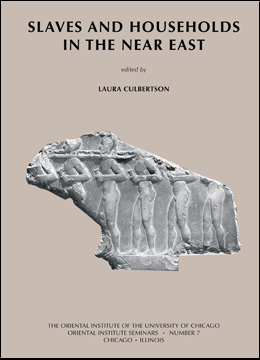OIS 7. Slaves and Households in the Near East Laura Culbertson, ed.
The seventh in the Oriental Institute Seminar Series, this volume contains papers that emerged from the seminar "Slaves and Households in the Near East" held at the Oriental Institute March 5-6, 2010. Despite widespread mention of enslaved people in historical records from the ancient, medieval, and early modern Near East, scholars struggle to understand what defines this phenomenon in both particular contexts and in general. The purpose of the seminar was to seek new understandings of slavery through scholarly exchange and exploration of new approaches. In particular, contributors examined slavery in the context of households, an approach that allows scholars to expose different dimensions of the phenomenon beyond basic economic questions. Households, whether domestic units, temples, or the building blocks of political organizations, can be used as the prism through which to view the dynamics among enslaved people and their immediate contacts. The volume contains micro-historical examinations of slavery in contexts spanning almost four millennia.
Table of Contents:
Preface
Introduction
1. Slaves and Households in the Near East. Laura Culbertson, University of Chicago
Section One: Early Mesopotamia
2. Slavery in Private Households toward the End of the Third Millennium B.C. Hans Neumann, Westfälische Wilhelms-Universität, Münster
3. A Life-Course Approach to Household Slaves in the Late Third Millennium B.C. Laura Culbertson, University of Chicago
4. Domestic Female Slaves during the Old Babylonian Period. Andrea Seri, University of Chicago
Section Two: The Islamic Near East
5. Preliminary Remarks on Slaves and Slave Labor in the Third/Ninth Century Abbasid Empire. Matthew S. Gordon, Miami University
6. An Empire of Many Households: The Case of Ottoman Enslavement. Ehud R. Toledano, Tel Aviv University
Section Three: Second and First Millennium Empires
7. Neither Slave nor Truly Free: The Status of the Dependents of Babylonian Temple Households. Kristin Kleber, Freie Universität Berlin
8. Slavery between Judah and Babylon: The Exilic Experience. F. Rachel Magdalene, Universität Leipzig; and Cornelia Wunsch, University of London
9. Household Structure and Population Dynamics in the Middle Babylonian Provincial "Slave" Population. Jonathan S. Tenney, Loyola University New Orleans and University of Copenhagen
Section Four: Response
10. Slaves and Households in the Near East: A Response. Indrani Chatterjee, Rutgers University
- Oriental Institute Seminars 7
- Chicago: The Oriental Institute, 2011
- ISBN-13: 978-1-885923-83-7
- Pp. viii + 152; 1 figure, 3 tables
- $24.95


